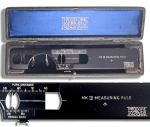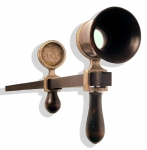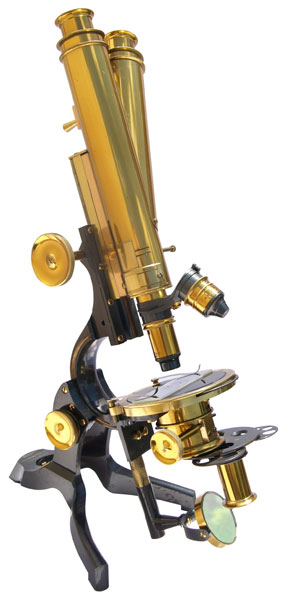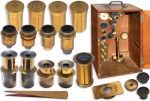Scientific Instruments > Scientific Optical
19th Century "The Challenge" Binocular Microscope by SWIFT & SONS, London.
Item#: SOI1052
SOLD
This binocular compound microscope is one of which it may be fairly said that it is surpassed by no other of its kind in its scientific ingenuity and the excellence of its workmanship. This black enamel and lacquered brass microscope was made by J. N. SWIFT & SONS, 81 Tottenham Court Road, London, and presented to Rev. Canon Smith by Parishioners and Friends on His Leaving Grange over Sands on May 1888. This Wenham type binocular stereomicroscope - named after Francis Herbert Wenham (1824-1908), uses Wenham achromatic prism to split the light beam at the rear of a single objective lens. The Wenham binocular body moves on the rack and pinion with oblique teeth for course and fine adjustment and has a single knob on the back for inter-ocular distance adjustment. The extremely sophisticated Sub-stage assembly combining an achromatic condenser lens, a swing-in lever with dark field stop for Black-ground Illumination and condenser plate that rotates through three positions. One position contains the Nicol polarizer along with a wheel of filters. A second has a wheel of seven varying stops. The third is a larger opening with a slip in ring intended to hold filters in place. The plano-concave mirror is attached to the stem by a crank-arm. This microscope can be used as a Polariscope. The Polariscope accessories include: A sub-stage Nicol prism polarizer, a rotating selenite plates, and a Nicol prism analyzer placed in a draw above the objective lens. The polarizer prism was invented by the Scottish physicist William Nicol (1768-1851). Other accessories include: Bull's eye condenser with a Plano-convex lens to cast a direct beam of light onto a specimen, four original Swift lenses and matching signed brass canisters and two sets of ocular eyepieces. James Swift a prolific Londoner optician, who worked for Andrew Ross, established his own business in 1857 with the name "J. Swift & Son, University Optical Works". The facility was located at 43 University Street from about 1872 until 1881, when it moved to 81 Tottenham Court Road, London. He was in partnership with his son, James Mansell Swift. The firm was fairly well known for its high quality scientific instruments including microscopes and accessories, petrological microscopes and instruments for mineralogy and crystal¬lography, including recording micrometers, etc. James Swift & son Ltd was the contractor to all scientific departments of H.M. Government. The company remained in business until the next century.
Related Items
-
 Price: $60.00
Price: $60.00 -
 Price: $70.00
Price: $70.00 -
 Price: $500.00
Price: $500.00
Development: Epoch | Design: Luch
Copyright © 1999-2024 Gilai Collectibles. All Rights Reserved







